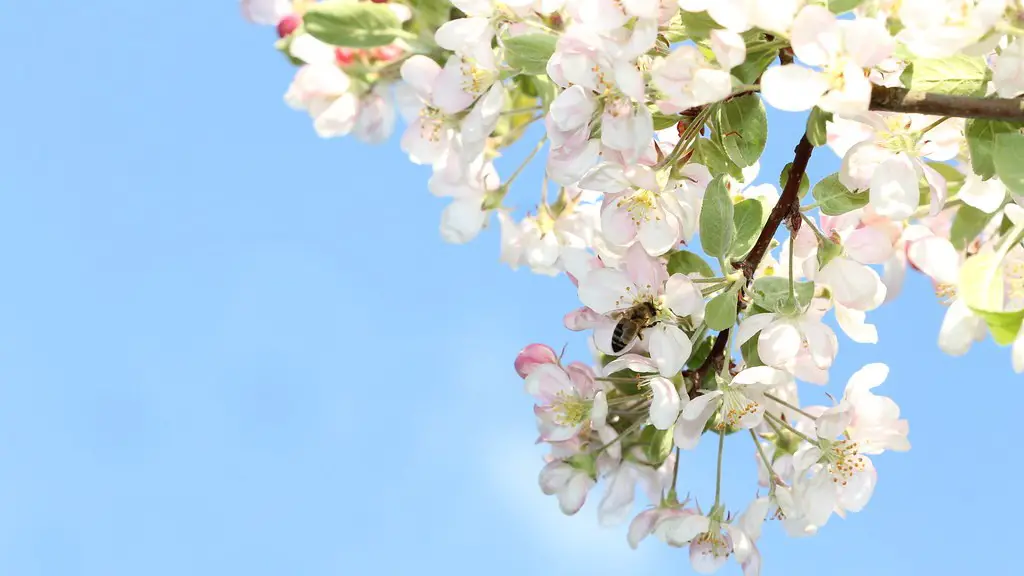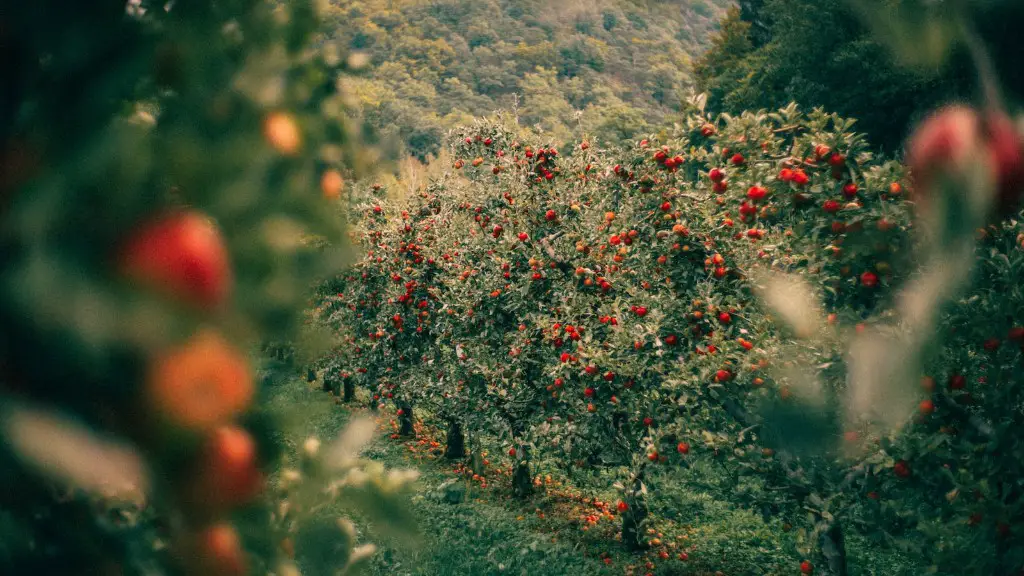Reviving an apple tree can be a tricky endeavor, especially when one doesn’t have the best knowledge of horticulture. In this blog post, I’ll explain how to properly and effectively bring an apple tree back to life. To start off, it’s important to examine the soil by taking a sample and having it tested. This allows one to know what nutrients the tree lacks, if at all. Then one should find a fertilizer that supplies the right mix of those nutrients and apply it in late winter when the soil is still cold.
The use of mulch is also critical in an apple tree revival. By choosing a mulch in the 8″ to 10″ range, one can reduce weeds and maintain the moisture necessary for the tree to thrive. The tree also needs enough water to grow. Thus, it’s important to water deeply with a slow trickle, rather than quickly with more water. After the time has passed for the fertilizer to take place, one should prune, shape and thin the tree in order to maximize its health.
If the tree continues to not give the desired results, one should consider looking into the insects and diseases that can attack apple trees. Planting apple trees in an area that receives a good amount of sunlight is an effective way to minimize damage from these factors. Finally, pesticides can be used to protect the tree from these kinds of pests, however, make sure to follow the label instructions explicitly.
Pruning
Pruning is an essential step in reviving an apple tree. Pruning serves two main purposes: it removes any damaged or dead branches that would otherwise take away from the tree’s overall health, and it also helps shape and thin the tree, allowing it to get enough sunlight and air circulation. One should prune the tree in late winter or early spring, depending on where one lives. Start with removing any dead or diseased branches, then thin it out, removing any branches that are crossing over each other, or that are too close together.
Finally, shape the tree, taking into consideration the desired height, width and shape of the tree. Make sure the top is not wider than the bottom, as this can lead to an unbalanced tree that can be difficult to manage. As far as tools go, loppers, pruning shears and a handheld saw are the main tools used when it comes to pruning apple trees.
Fertilizer
Fertilizer is essential to revive an apple tree, but one has to be careful with the type and amount of fertilizer used. First and foremost, one should take a soil sample and get it tested so that one knows what nutrients the tree needs. Then find a fertilizer that has the right mix of those nutrients and apply it in late winter, when the soil is still cold. Organic fertilizers, like compost, can also be used, but have a lower nutrient content, so one needs to use more of it than a chemical fertilizer.
When applying the fertilizer, it’s important to spread it evenly around the tree. Most fertilizer bags give instructions on how much to apply, but typically one should use one pound per every inch of tree diameter, or one foot deep. However, it’s best to consult with a nursery or horticulturalist in order to get a better recommendation of how much and what type of fertilizer to use.
Soil Conditions
It is essential that the soil in which the apple tree is planted has the right conditions so that it can grow and thrive. Soil pH is an important factor to consider, as most apple trees prefer slightly acidic soils, usually between 5.5 and 6.5. Additionally, the soil should be well-draining, as waterlogged soil can lead to root rot, which can in turn kill the tree. Lastly, the soil should have adequate amounts of organic matter, like compost and mulch, as this allows for better air and water circulation.
If for some reason the soil pH is not adequate, there are various products available in nurseries and garden centers that can help adjust it to the desired level. Additionally, one can use soil-building products like compost and mulch to ensure that the soil has plenty of organic matter. This way, one can be sure that the tree will be planted on the right soil.
Mulch
Mulch is essential when trying to revive an apple tree. Proper mulching helps to retain moisture, prevents weeds, and also helps in insulating the roots of the tree. One should strive to use a mulch that is 8″ to 10″ deep so that there are enough benefits, but not too much. Additionally, the mulch should be at least two feet away from the trunk, as the mulch should not touch the tree directly.
Organic mulches, like bark, wood chips, and leaves, are great for apple trees, as they not help with the revival, but also provide necessary nutrients for the tree. On the other hand, inorganic mulches, such as plastic and rubber, can limit air and water circulation, so it’s best to avoid them if possible. Lastly, it’s important to remember to keep the mulch topped off throughout the year.
Watering
Watering an apple tree is just as important as any other aspect of its health. The tree needs a certain amount of water to survive, however, one should be careful not to over-water, as this can lead to root rot. Also, it’s important to water deeply, rather than quickly, as this encourages deeper root growth.
When it comes to how much water is necessary, the general rule of thumb is to provide 1 inch of water per week. Of course, this will depend on the climate and the soil type, so it’s best to consult with a horticulturalist or a nursery to get a better indication of how much water the tree needs. Additionally, one can use a moisture meter or a soil testing kit to get an accurate measurement of the soil’s moisture content.
Insects and Diseases
Insects and diseases can cause a great deal of damage to an apple tree’s health, thus it’s important to be on the lookout for signs of damage. Planting the apple tree in an area that receives full sun can help deter certain pests, like aphids and mites. Additionally, general cleanliness around the tree is important in order to avoid diseases and insect infestations. One should also check for any signs of damage during the pruning process.
If one does find signs of infestation or disease, then one should look into using pesticides as a way to combat these pests. However, it is important to follow the label instructions when using any kind of pesticide, as misusing them can be a serious risk to the tree’s health. If in doubt, don’t hesitate to consult with a local horticulturalist to get a better understanding of the issue.
Grafting
Grafting can be used to revive an apple tree in some cases. It involves taking a branch from one specific type of apple tree, and attaching it to a different variety of apple tree. This method can be useful if one wants to introduce some beneficial traits, like disease resistance or earlier ripening, into an ailing apple tree. The branch must be taken from an apple tree that is the same size as the one that is being grafted.
Grafting can also be used to add more branches to a tree. First, one needs to make a shallow ‘V’ cut into the side of the tree. Then, one needs to insert the branch into the ‘V’ and secure it tightly with a tape or hose clamp. It’s important to trim off any excess branches before tying the graft, as this will help the branch settle in. Lastly, be sure to constantly check that the graft is secure and that the branch is taking.
Wrapping
Wrapping an apple tree can help provide additional protection during the winter months. This is especially important for young trees, as they are more susceptible to extreme temperatures and weather conditions. Wrapping an apple tree should be done with a breathable material, like burlap or garden fabric, as this allows some air to circulate while still giving the needed protection.
The tree should be wrapped on the trunk and branches, starting from the bottom and going up. Additionally, the wrap should be tied tightly but not too tight, so the tree can still get some air circulation. One should also make sure to remove the wrap in the spring or else it could damage the tree. Lastly, pruned branches should be sealed with a tree wrap or pruning sealer to avoid fungal infection.




